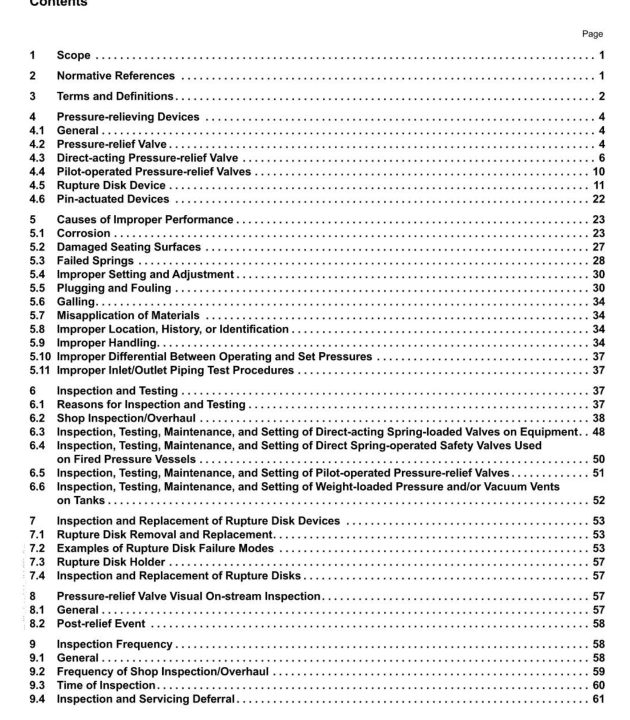API RP 576 pdf download

API RP 576 pdf download Inspection of Pressure-relieving Oevices
3.29trim
Refers to internal parts of a pressure-relief valve that are manufactured using materials that are resistant todegradation from the associated process. At a minimum, it refers to the nozzle and disc, but may also includeother components that are in contact with the process fluids (disc holder, blowdown ring, guide, spindle, etc.)or are required for proper valve performance.
4Pressure-relieving Devices4.1General Pressure-relieving devices protect equipment and personnel by opening at predetermined pressures andpreventing the adverse consequences of excessive pressures in process systems and storage vessels.
A pressure-relief device is actuated by inlet static pressure and designed to open during emergency orabnormal conditions to prevent a rise of internal fluid pressure in excess of a specified design value. Thedevice may also be designed to prevent excessive internal vacuum. The device may be a pressure-reliefvalve,a nonreclosing pressure-relief device, or a vacuum-relief valve.
Common examples include direct spring-loaded pressure-relief valves, pilot-operated pressure-relief valves,rupture disks, buckling pin devices, and weight-loaded devices.
Refer to API 520,Part ! or API 2000 for more information regarding pressure-relief device designconsiderations.
4.2Pressure-relief Valve4.2.1General
A pressure-relief valve is designed to open for the relief of excess pressure and reclose thereby preventingfurther flow of fluid after normal conditions have been restored. A pressure-relief valve opens when itsupstream pressure reaches the opening pressure. It then allows fluid to flow until its upstream pressure falls to the closing pressure. Iit then closes, preventing further flow.The term pressure-relief valve is generic in nature,and these devices can be classified as a safety valve, relief valve, or a safety relief valve.
4.2.2Safety Valve
A safety valve is a pressure-relief valve that is actuated by the static pressure upstream of the valve and characterized by rapid opening or pop action. A safety valve is normally used with compressible fluids. Safetyvalves are used on steam boiler drums and superheaters and are also used for general air, gas, and steamservices in refinery and petrochemical plants.
When the static inlet pressure reaches the set pressure, it will increase the pressure upstream of the disc andovercome the seating force on the disc. Fluid will then enter the huddling chamber,providing additionalopening force. This will cause the disc to lift and provide full opening at specified overpressure.The closingpressure will be less than the set pressure and will be reached after the blowdown phase is completed.
4.2.3 Relief Valve
A relief valve is a pressure-relief valve actuated by the difference between static pressure upstream of thevalve and superimposed backpressure downstream (unless pressure compensated,i.e. with bellows orbalancing) and opens normally in proportion to the pressure increase over the opening pressure. A relief valveis normally used with incompressible fluids.A relief valve begins to open when the static inlet pressurereaches its set pressure.When the static inlet pressure overcomes the seating force, the disc begins to lit offthe seat,allowing flow of the liquid. The value of the closing pressure is lower than the set pressure and will bereached after the blowdown phase is complete.
4.2.4 Saf e ty Re li ef Valve A safety relief valve is a pressure-relief valve that may be used as either a safety or relief valve depending on the application. The trim of the safety relief valve will provide stable lifting characteristics on either compressible or incompressible media.
4.3 Direct-acting Pressure-relief Valve
4.3.1 Ge neral A direct-acting pressure-relief valve uses a weight or compressed spring to hold the valve seat closed below the set pressure or vacuum setting of the device
4.3.2 Weight-Ioaded Pre ss ure- lV acuum-relief Valve These devices are used in pressure and/or vacuum protection applications where operating pressures are very near atmospheric conditions. The set pressure or vacuum setting can be changed by adding or removing weights in the seating area of the valve. These devices are normally vented to atmosphere (see Figure 1 ). They are often used to satisfy the normal venting requirements caused by thermal inbreathing/outbreathing and product pump-in/pump-out effects.









